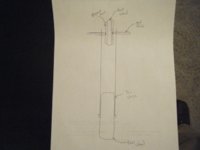pregrid
XS650 Guru
What's the best way to align the front wheel with the rear? String, tape, laser? i'm not talking side to side but aligning both tires on the same track.

align the rear by measuring center of swing arm pivot to center of rear axle, both sides equal
Dave, did you ever try checking the alignment? I'm wondering if misalignment is the reason my '81 street tracker seems to wear the center of the rear tire much faster than my friend's '81 stock bike (which was kept in my garage for a couple years and we rode together for most of the first 8k miles on the tires, which were the same brand and model, though his rear is 16" and mine us 18"). No big differences in riding style, neither of us has the skill to be a hooligan, and my bike is lighter, especially in the rear.
I've never had any stability problems, even with the rear loaded for a long trip with camping gear, or with a 50# bag of dog food strapped to the tail piece (not recommended for paint care...)
I had a thought that if the rear was at an angle compared to the front it might scrub the center off.
Thanks,
John
Do you use the rear brake for most of your braking? Also, high 30's is way overkill unless you are 300+ lbs, I run at around 25-30 psi for a smooth ride.
